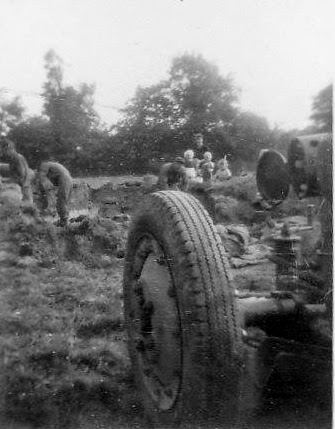The family had lived in their Southern California house since it was built in 1932, and the items at their estate sale showed that they saved a lot of stuff over the decades.
One upstairs room was full of old books, magazines, photographs, Christmas music books -- and a sheet of instructions for a toy that had long since vanished from the family's collection. I brought it home with the other items I purchased.
Knerr and Melin had formed Wham-O, working out of a garage in Pasadena, California back in 1948, and spent many years making slingshots and other toys. Marketing the Frisbee and the Hula Hoop from their home office in nearby San Gabriel in the late 1950s made their business not just take off, but explode and rain down dollars on the creators. They sold more than 100 million Hula Hoops within two years.
Newspaper articles from back in the day show how adults tried to get their minds around the popularity of the Hula Hoop. In August 1958, a columnist for the Long Beach, California Independent Press- Telegram moaned that the "spasms of the human trunk" required to keep the Hula Hoop going would turn a generation of kids into small Elvis Presleys:
Economics aside, to really appreciate just how significant Wham-O was, you had to have been a kid between about the late 1950s through the 1970s. Wham-O created and popularized not only the Frisbee (1957) and the Hula Hoop (1958), but also the Slip N' Slide (1961), the Super Ball (1965) and many other toys.
My own memories of Wham-O toys are mostly fond ones. Most kids, athletic or not, could -- with practice -- figure out how to get a hula hoop to work.
We stood around in the driveway, the yard or the sidewalk for extended periods of time, practicing. You could even play with your hula hoop in the house if your room was big enough. And your parents could even use it as an exercise device, if they were so inclined.
But Wham-O toys also had an unspoken element of danger to them, so appealing to the midcentury child who also rode a bike without a helmet and roller skated without knee and elbow pads. You could get hurt trying to dive through a hula hoop or using it like a jump rope, after all.
Cooling off in the summer was easier when you or a neighbor kid had a Slip N' Slide and a big grassy lawn, and your parents would let you hook up the garden hose to get it to work. That was also a little risky, particularly if there were small, sharp rocks underneath the long yellow expanse of "slide" on the ground.
The back of the hula hoop instruction sheet shows a variety of other toys and games made by Wham-0 in the late 1950s.
Most of them are not well-remembered, but the one in the lower left-hand corner is perhaps even more beloved than the Hula Hoop and the Slip N' Slide.
A Frisbee could do some damage, too -- although probably not as much as a baseball or softball if it veered off course. You had to have a lot of space to throw a Frisbee, and preferably someone else to catch it (a relative, a friend, or the family dog) unless you could get it to boomerang consistently.
Almost every kid I knew wanted a Super Ball in the mid-1960s -- and talk about needing space to play with it. Super Balls took over the outdoor basketball courts at school during the Christmas holidays, as kids (usually boys) tried to throw it down so hard that it would bounce higher than anyone else's. Catching a Super Ball was somewhat problematic, particularly because it didn't always bounce the second, third, or fourth time where you thought it might. But the kids in our neighborhood were up to the challenge. Some of them also learned the hard way why you weren't supposed to bounce it in the house.
And if you are a football fan, you might be interested to know that the Super Bowl owes its name to the Super Ball:
http://www.history.com/news/super-bowl-owes-its-name-to-a-bouncy-ball
Wham-O has been sold and resold over the years; the toys and games they created in the 1950s and 1960s are the stuff of legend, dreams and memories.
_______________________________________
You can read more about the company's history here:
http://www.wham-o.com/about-us/our-heritage/
Here's a link to a couple of original TV ads for the Slip N' Slide and the Wham-O Water Wiggle:
https://www.youtube.com/watch?v=JvGH8n0_-pw























































